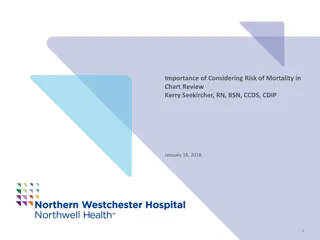Understanding Mortality Reviews and Their Impact on Quality of Care
Mortality reviews play a vital role in assessing the quality of care provided by healthcare facilities. By analyzing observed versus expected mortality rates, healthcare organizations can identify areas for improvement and enhance patient outcomes. The APR-DRG system, including Severity of Illness and Risk of Mortality scores, helps in determining the level of care needed for patients. Accurate coding and clinical specificity are crucial for achieving accurate mortality scores and improving overall patient care quality.
Download Presentation

Please find below an Image/Link to download the presentation.
The content on the website is provided AS IS for your information and personal use only. It may not be sold, licensed, or shared on other websites without obtaining consent from the author. Download presentation by click this link. If you encounter any issues during the download, it is possible that the publisher has removed the file from their server.
E N D
Presentation Transcript
By JeanAnn Corbett RN, BSN, CCDS University of Kansas Health System ANATOMY OF A MORTALITY REVIEW
OBJECTIVES Purpose of mortality review Tools and terms related to mortality review How does CDI make a difference with mortality reviews? Case study/example(s) Related Official Coding Guidelines and Coding Clinics Mortality reviews at KU
PURPOSE Mortality reviews can drastically affect the accuracy of quality scores Mortality scoring, if used properly, can help with the cost and the quality of care CMS uses mortality data to financially penalize and reward organizations under the Hospital Value-Based Purchasing Program Private data mining companies pull MedPAR data related to hospitals mortality scores and then employ their own algorithms to compare one facility, or one physician, to another. Mortality scores are available on the internet (LeapFrog, US News and World Report, Hospital Compare, etc.) and based on documentation-so if it s not correct in the record, then it won t be coded correctly and the mortality scores will be inaccurate
OBSERVED TO EXPECTED RATIO (O/E) Mortality index is the number of patient deaths in a hospital within a ratio (O/E ratio) that compares actual deaths within a specific time period to expected deaths pulled from risk of mortality data Observed mortality is represented by the actual number of patients that died in the hospital in a specific time frame (month, quarter, year etc.) The expected mortality is the average expected number of deaths based upon diagnosed conditions, age, gender, etc. within the same timeframe The ratio is computed by dividing the observed mortality rate by the expected mortality rate The lower the score the better; scores of <1 indicate that less patients died than expected, scores >1 indicate more patients died than expected
APR-DRG (ALL PAYOR REFINED DRG) Created by 3M in a joint effort with NACHRI (National Association of Children s Hospitals and Related Institutions) and was originally released in December 1990 APR-DRG vs MS-DRG: All APR-DRGs have 4 severity levels, Patient age is used in severity leveling and significant pediatric and adult problems have a separate APR-DRG Designed to be fully comprehensive and account for all payors, patients and ages (including pregnant women, newborns, and pediatrics) APR-DRG dependent upon complete and accurate coding and clinical specificity; takes into account Principal diagnosis, secondary diagnoses and procedures Underlying clinical principle that the severity of illness and risk of mortality of a patient depends to a great extent on the patient s underlying characteristics APR-DRG assigns a Severity of Illness/SOI (extend of physiologic decomposition or organ system loss of function) and Risk of Mortality/ROM (the likelihood of dying) subclass, which is assigned one of the following levels: 1=Minor, 2=Moderate, 3=Major 4=Extreme Goal SOI/ROM score for a mortality review is 4/4
HOW CDI CAN MAKE A DIFFERENCE Capture all secondary diagnoses that meet reporting requirements especially those that aren t related to the PDX Improve specificity of secondary diagnoses Collaborate with the core measures team and quality department Ensure accurate assignment of the POA indicator Mortality scores are dependent on documentation, if it is incomplete or inaccurate then so are the scores CDI reviews on some cases may highlight performance improvement opportunities for the organization If the documentation states Persistent Vegetative State and the GCS score is 3-8, query for clarification for coma Cannot report Unspecified coma (R40.20) in addition to GCS scores
OFFICIAL CODING GUIDELINES & RELATED CODING CLINICS e. Coma scale The coma scale codes (R40.2-) can be used in conjunction with traumatic brain injury codes, acute cerebrovascular disease or sequelae of cerebrovascular disease codes. These codes are primarily for use by trauma registries, but they may be used in any setting where this information is collected. The coma scale may also be used to assess the status of the central nervous system for other non-trauma conditions, such as monitoring patients in the intensive care unit regardless of medical condition. The coma scale codes should be sequenced after the diagnosis code(s). These codes, one from each subcategory, are needed to complete the scale. The 7th character indicates when the scale was recorded. The 7th character should match for all three codes. At a minimum, report the initial score documented on presentation at your facility. This may be a score from the emergency medicine technician (EMT) or in the emergency department. If desired, a facility may choose to capture multiple coma scale scores. Assign code R40.24, Glasgow coma scale, total score, when only the total score is documented in the medical record and not the individual score(s). Do not report codes for individual or total Glasgow coma scale scores for a patient with a medically induced coma or a sedated patient.
MORTALITY REVIEWS AT KU All mortalities are reviewed (regardless of payor) with the exception of patients who expire in the ED prior to IP admission SOI/ROM < 4/4 is sent for a second level CDI review and possibly a third level review by Team Lead/CDI manager pending outcome of the second level review Also use Vizient (formerly University HealthSystem Consortium, or UHC) mortality index, which is calculated based on all the conditions that were present on admission only and the review process is more about making the record as complete and accurate from start to finish to ensure the mortality scores correspond to the patient s actual severity and risk KU has a Mortality review committee that meets weekly Criteria for review by the Mortality committee: Automatic Triggers: Autopsy cases, Outside of ICU Code Blue, PEDS/PICU/NICU Death within 48 hours after arrival After a summary is presented by the parties involved (Providers, Nurse Manager, other pertinent parties) the mortality is determined to be one of the following: Preventable with opportunity Potentially preventable with opportunity Non-preventable with opportunity Non-preventable without opportunity All people concerns are done at a peer to peer level
REFERENCES All Patient Refined DRGs (APR-DRGs) An Overview Presented by Treo Solutions https://www.bcbst.com/providers/webinar/APRDRG.pdf Know how APR-DRGs can assist with physician profiling JustCoding News: Inpatient, May 9, 2012 Q&A: Mortality rate, observed/expected CDI Strategies, Volume 10, Issue 26, June 16, 2016 Mortality reviews and publicly reported quality data CDI Journal, Volume 12, Issue 6, November 1, 2018 Exploring Mortality Scores: How Mortality Scores Improve Quality Data Pam Hess, MA, RHIA, CDIP, CCS, CPC and Susan Schmitz, JD, BSN, RN, CCS, CCDS, CDIP 2018 ACDIS Conference 3M CDI Educational Network Webinar Glascow Coma Scale January 18, 2019 Cheryl Mancenton, RN























